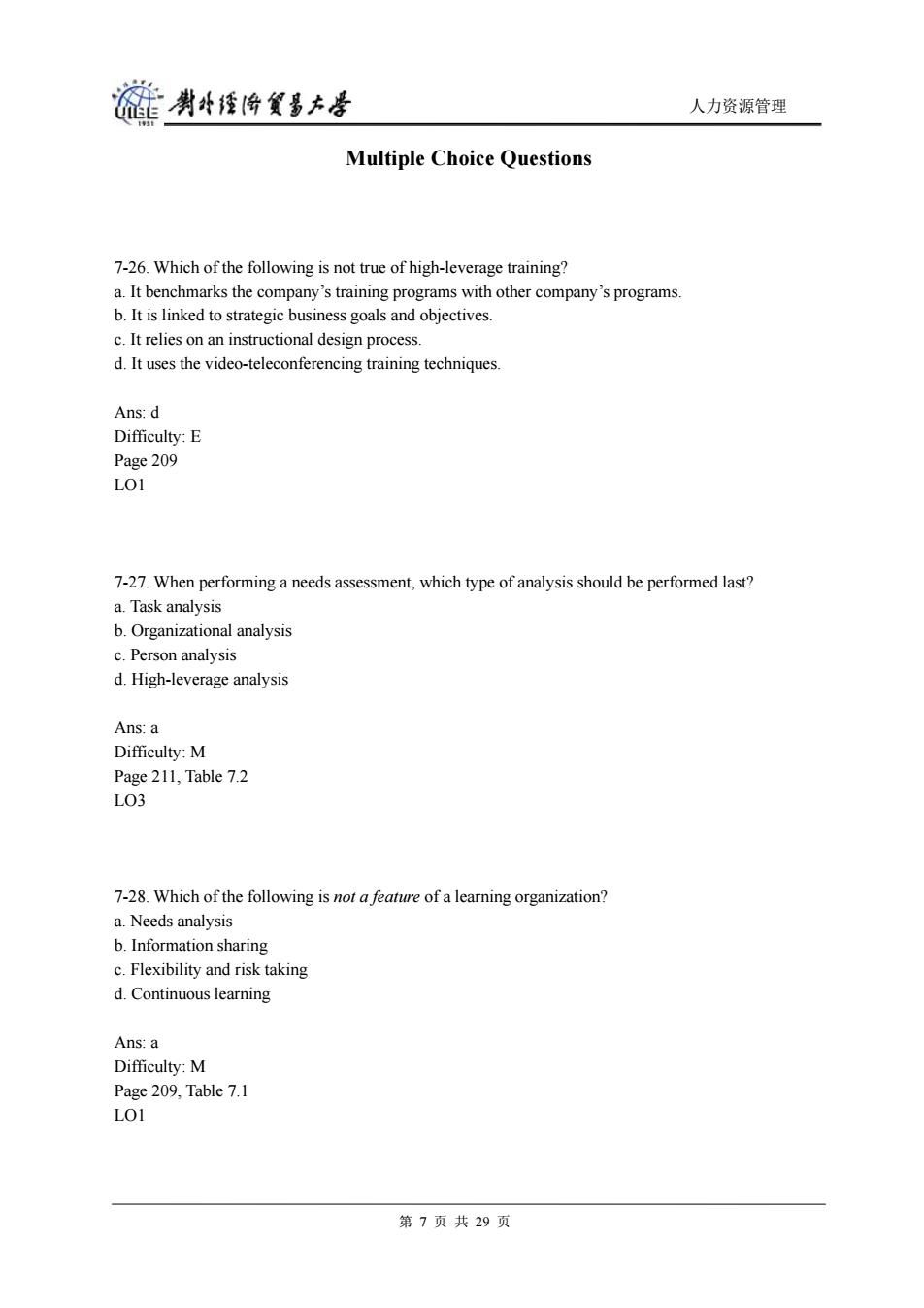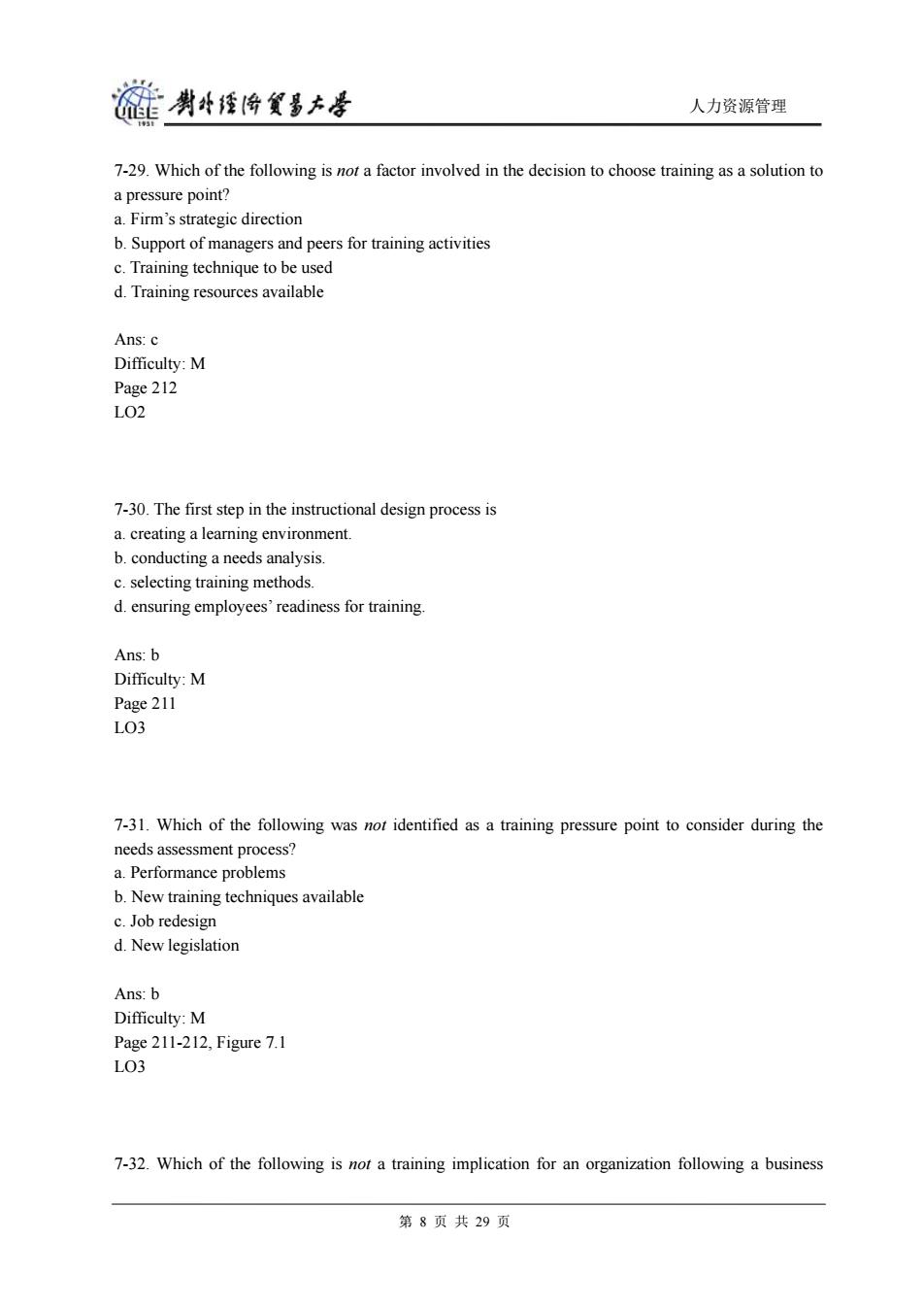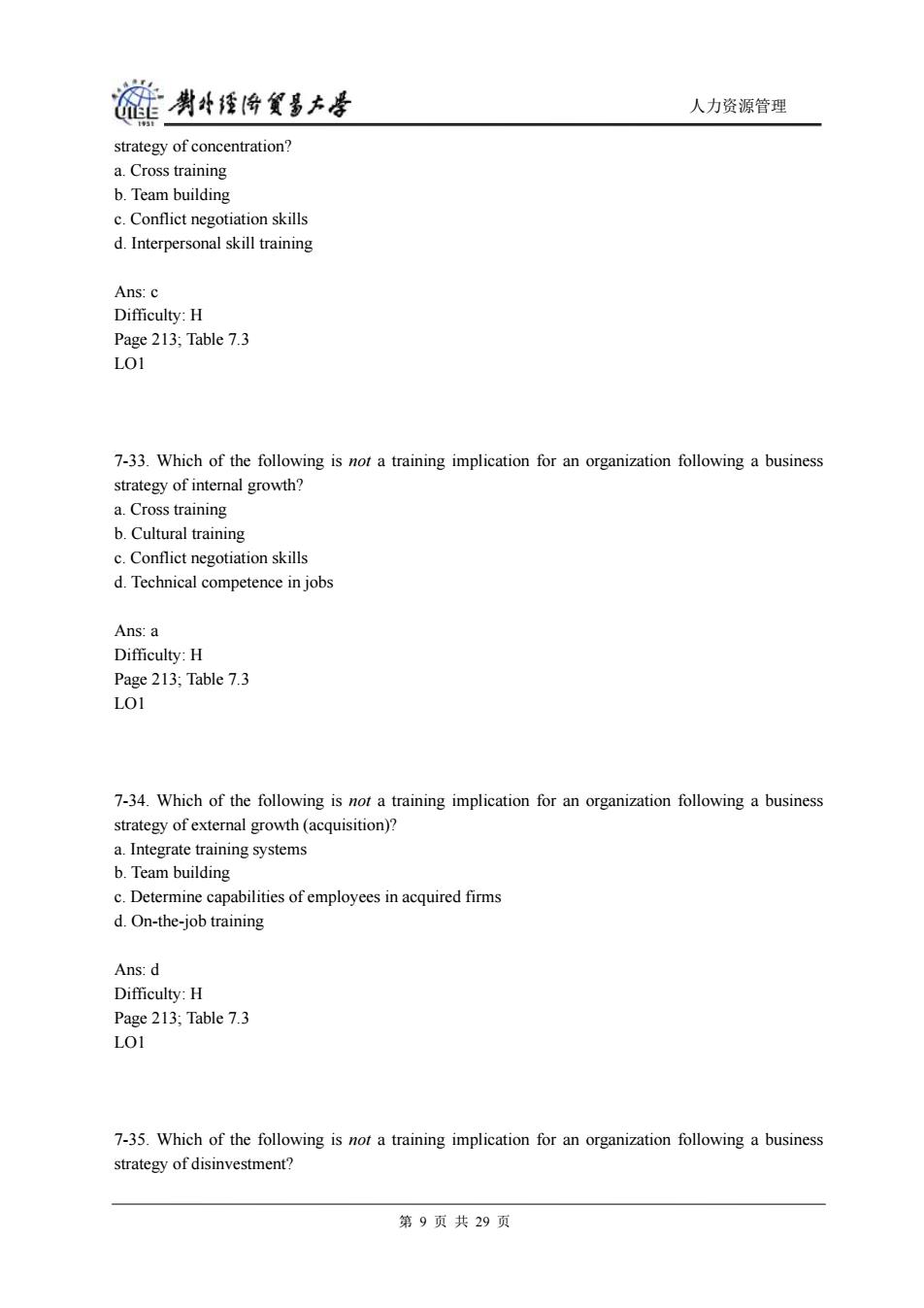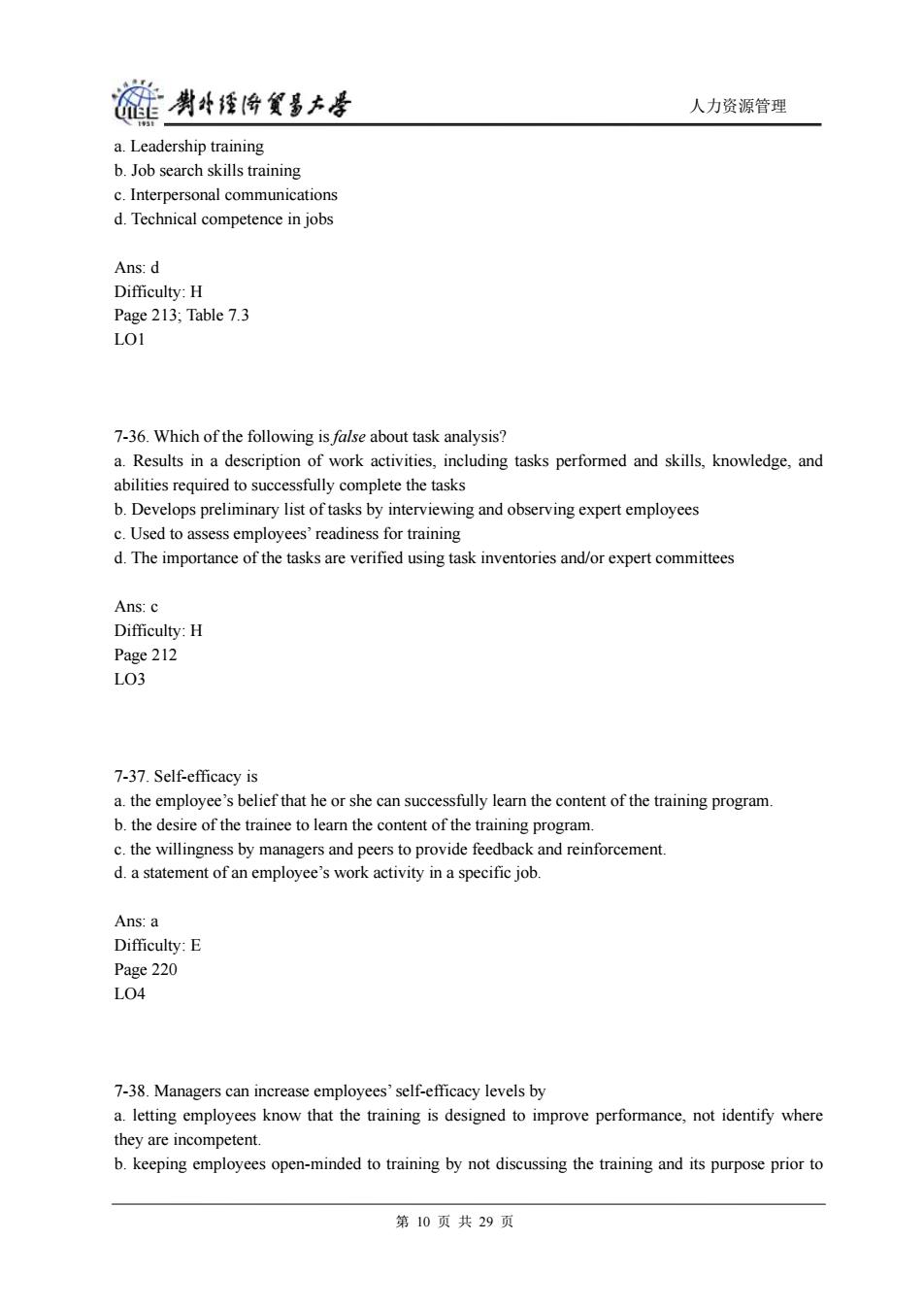
肖外径份氨多本是 人力资源管理 7-22.Evaluation designs without pretesting or comparison groups are most appropriate when the manager Is interested in identifying If a specific level of performance has been achieved. Ans:T Difficulty:M Page 246 LO8 7-23.Cost-benefit analysis is the process of determining the economic benefits of a training program using accounting methods. Ans:T Difficulty:E Page 247 LO8 7-24.One method for identifying the benefits of training is to check the technical,academic,and/or practitioner literature. Ans:T Difficulty:E Page 248 LO8 7-25.Cross-cultural preparation involves educating employees only who are being sent to a foreign country. Ans:T Difficulty:E Page 252 L09 第6页共29页
人力资源管理 7-22. Evaluation designs without pretesting or comparison groups are most appropriate when the manager Is interested in identifying If a specific level of performance has been achieved. Ans: T Difficulty: M Page 246 LO8 7-23. Cost-benefit analysis is the process of determining the economic benefits of a training program using accounting methods. Ans: T Difficulty: E Page 247 LO8 7-24. One method for identifying the benefits of training is to check the technical, academic, and/or practitioner literature. Ans: T Difficulty: E Page 248 LO8 7-25. Cross-cultural preparation involves educating employees only who are being sent to a foreign country. Ans: T Difficulty: E Page 252 LO9 第 6 页 共 29 页

莲喇母透降贸多大学 人力资源管理 Multiple Choice Questions 7-26.Which of the following is not true of high-leverage training? a.It benchmarks the company's training programs with other company's programs. b.It is linked to strategic business goals and objectives. c.It relies on an instructional design process. d.It uses the video-teleconferencing training techniques. Ans:d Difficulty:E Page 209 L01 7-27.When performing a needs assessment,which type of analysis should be performed last? a.Task analysis b.Organizational analysis c.Person analysis d.High-leverage analysis Ans:a Difficulty:M Page 211,Table 7.2 L03 7-28.Which of the following is not a feature of a learning organization? a.Needs analysis b.Information sharing c.Flexibility and risk taking d.Continuous learning Ans:a Difficulty:M Page 209,Table 7.1 L01 第7页共29页
人力资源管理 Multiple Choice Questions 7-26. Which of the following is not true of high-leverage training? a. It benchmarks the company’s training programs with other company’s programs. b. It is linked to strategic business goals and objectives. c. It relies on an instructional design process. d. It uses the video-teleconferencing training techniques. Ans: d Difficulty: E Page 209 LO1 7-27. When performing a needs assessment, which type of analysis should be performed last? a. Task analysis b. Organizational analysis c. Person analysis d. High-leverage analysis Ans: a Difficulty: M Page 211, Table 7.2 LO3 7-28. Which of the following is not a feature of a learning organization? a. Needs analysis b. Information sharing c. Flexibility and risk taking d. Continuous learning Ans: a Difficulty: M Page 209, Table 7.1 LO1 第 7 页 共 29 页

肖外径份氨多本是 人力资源管理 7-29.Which of the following is not a factor involved in the decision to choose training as a solution to a pressure point? a.Firm's strategic direction b.Support of managers and peers for training activities c.Training technique to be used d.Training resources available Ans:c Difficulty:M Page 212 L02 7-30.The first step in the instructional design process is a.creating a learning environment. b.conducting a needs analysis c.selecting training methods. d.ensuring employees'readiness for training. Ans:b Difficulty:M Page 211 L03 7-31.Which of the following was not identified as a training pressure point to consider during the needs assessment process? a.Performance problems b.New training techniques available c.Job redesign d.New legislation Ans:b Difficulty:M Page 211-212,Figure 7.1 LO3 7-32.Which of the following is not a training implication for an organization following a business 第8页共29页
人力资源管理 7-29. Which of the following is not a factor involved in the decision to choose training as a solution to a pressure point? a. Firm’s strategic direction b. Support of managers and peers for training activities c. Training technique to be used d. Training resources available Ans: c Difficulty: M Page 212 LO2 7-30. The first step in the instructional design process is a. creating a learning environment. b. conducting a needs analysis. c. selecting training methods. d. ensuring employees’ readiness for training. Ans: b Difficulty: M Page 211 LO3 7-31. Which of the following was not identified as a training pressure point to consider during the needs assessment process? a. Performance problems b. New training techniques available c. Job redesign d. New legislation Ans: b Difficulty: M Page 211-212, Figure 7.1 LO3 7-32. Which of the following is not a training implication for an organization following a business 第 8 页 共 29 页

渊外径舍贺多大景 人力资源管理 strategy of concentration? a.Cross training b.Team building c.Conflict negotiation skills d.Interpersonal skill training Ans:c Difficulty:H Page 213;Table 7.3 LOI 7-33.Which of the following is not a training implication for an organization following a business strategy of internal growth? a.Cross training b.Cultural training c.Conflict negotiation skills d.Technical competence in jobs Ans:a Difficulty:H Page 213;Table 7.3 LOI 7-34.Which of the following is not a training implication for an organization following a business strategy of external growth(acquisition)? a.Integrate training systems b.Team building c.Determine capabilities of employees in acquired firms d.On-the-job training Ans:d Difficulty:H Page 213;Table 7.3 L01 7-35.Which of the following is not a training implication for an organization following a business strategy of disinvestment? 第9页共29页
人力资源管理 strategy of concentration? a. Cross training b. Team building c. Conflict negotiation skills d. Interpersonal skill training Ans: c Difficulty: H Page 213; Table 7.3 LO1 7-33. Which of the following is not a training implication for an organization following a business strategy of internal growth? a. Cross training b. Cultural training c. Conflict negotiation skills d. Technical competence in jobs Ans: a Difficulty: H Page 213; Table 7.3 LO1 7-34. Which of the following is not a training implication for an organization following a business strategy of external growth (acquisition)? a. Integrate training systems b. Team building c. Determine capabilities of employees in acquired firms d. On-the-job training Ans: d Difficulty: H Page 213; Table 7.3 LO1 7-35. Which of the following is not a training implication for an organization following a business strategy of disinvestment? 第 9 页 共 29 页

莲剥4将发多大号 人力资源管理 a.Leadership training b.Job search skills training c.Interpersonal communications d.Technical competence in jobs Ans:d Difficulty:H Page 213;Table 7.3 LOI 7-36.Which of the following is false about task analysis? a.Results in a description of work activities,including tasks performed and skills,knowledge,and abilities required to successfully complete the tasks b.Develops preliminary list of tasks by interviewing and observing expert employees c.Used to assess employees'readiness for training d.The importance of the tasks are verified using task inventories and/or expert committees Ans:c Difficulty:H Page 212 L03 7-37.Self-efficacy is a.the employee's belief that he or she can successfully learn the content of the training program. b.the desire of the trainee to learn the content of the training program. c.the willingness by managers and peers to provide feedback and reinforcement. d.a statement of an employee's work activity in a specific job. Ans:a Difficulty:E Page 220 L04 7-38.Managers can increase employees'self-efficacy levels by a.letting employees know that the training is designed to improve performance,not identify where they are incompetent. b.keeping employees open-minded to training by not discussing the training and its purpose prior to 第10页共29页
人力资源管理 a. Leadership training b. Job search skills training c. Interpersonal communications d. Technical competence in jobs Ans: d Difficulty: H Page 213; Table 7.3 LO1 7-36. Which of the following is false about task analysis? a. Results in a description of work activities, including tasks performed and skills, knowledge, and abilities required to successfully complete the tasks b. Develops preliminary list of tasks by interviewing and observing expert employees c. Used to assess employees’ readiness for training d. The importance of the tasks are verified using task inventories and/or expert committees Ans: c Difficulty: H Page 212 LO3 7-37. Self-efficacy is a. the employee’s belief that he or she can successfully learn the content of the training program. b. the desire of the trainee to learn the content of the training program. c. the willingness by managers and peers to provide feedback and reinforcement. d. a statement of an employee’s work activity in a specific job. Ans: a Difficulty: E Page 220 LO4 7-38. Managers can increase employees’self-efficacy levels by a. letting employees know that the training is designed to improve performance, not identify where they are incompetent. b. keeping employees open-minded to training by not discussing the training and its purpose prior to 第 10 页 共 29 页